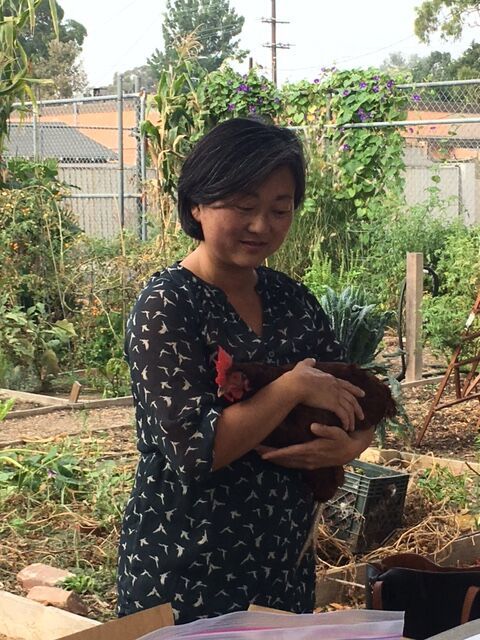LBO Workshop: Permaculture
Permaculture design can be complicated. Perhaps that’s why Master Gardener Roberta Kato brought her Rhode Island Red chicken, Peanut, to help explain.
While Kato went over the 12 principles of the eco-friendly design philosophy at the Aug. 26 Permaculture Workshop at Mary Molina Garden, Peanut demonstrated some of the tenets by scratching for grubs in the compost pile, nesting in people’s laps, and clucking in approval as she surveyed the community garden.
Chickens, Kato reminded attendees, are key to living a permaculture dream. “I’m not saying everyone has to have chickens,” she said, “But it’s something that’s helpful to have.”
 Roberta Kato and her chicken, Peanut.
Roberta Kato and her chicken, Peanut.
Chickens are high yield and serve multiple purposes. They produce a steady supply of eggs for breakfast, baking, or bartering. Their meat can be consumed. And they even turn the compost pile.
Poultry can help you follow the permaculture principle of producing no waste. They eat insects that prey on produce, as well as plant trimmings and refuse. And of course they contribute plenty of manure to fertilize crops.
Kato said she initially bought feed for her 20 chickens, when a co-worker from Nepal reminded her that chickens can find food on their own. Back in Nepal, the co-worker said, villagers tied identifying colored thread to their chickens’ legs and let them forage on their own all day.
If you’re interested in living the permaculture dream, Kato suggests you begin by observing your environment. Divide your living environment into zones: those you use every day, every other day, or a couple of times a week; and those you visit weekly or monthly. Think about the light, wind, and moisture conditions in those zones.
Swales can be used to collect water, walls can be painted white to reflect light, and concrete can absorb heat from the sun. In addition, arbors use patterns from nature, and shade plants can live within tree driplines.
“Permaculture ideas can be applied anywhere,” said Kato, who also has bees, bunnies, ducks, dogs, and cats.
The 12 principles of permaculture are:
- Observe and interact: Know your site and local conditions.
- Catch and store energy: Collect abundant resources for later use.
- Obtain a yield: Yield food crops and less tangible items.
- Apply self-regulation and respond to feedback: Protect land for yourself and future generations.
- Use renewable resources: Find and use things that have multiple purposes.
- Produce no waste: Reuse everything in the garden.
- Design from pattern: Mimic patterns in nature.
- Integrate rather than separate: Group plants to cooperate not compete.
- Use small and slow solutions: Let small parts contribute to overall function of garden.
- Use and value diversity: Plant new and favorite varieties to create balanced ecosystem.
- Use the edges: Make use of all possible space.
- Respond creatively to change: Adapt to rainfall, temperature, and pests.
The Aug. 26 permaculture workshop was one in a series of ongoing Long Beach Organic events on gardening topics.
- Margo McCall